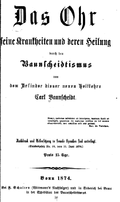Baunscheidtism



Baunscheidtism is a form of alternative medicine or therapy invented in the mid-19th century by Carl Baunscheidt. Baunscheidtism revolves around the concept of artificially creating small openings in the skin to facilitate the exit of supposed harmful bodily substances, a process Baunscheidt termed "exanthematic therapy." This practice was based on Baunscheidt's belief that many diseases are caused by the body's inability to expel toxic substances. He invented a device known as the "Lebenswecker" or "Life Awakener" to implement this therapy. The Lebenswecker is a small, hand-held instrument equipped with several fine needles designed to puncture the skin superficially.
History[edit]
Carl Baunscheidt, a German mechanic, developed Baunscheidtism in the 1850s after observing that a mosquito bite seemed to relieve pain in his rheumatic hand. Inspired by this incident, Baunscheidt devised the Lebenswecker and a special oil, "Baunscheidt Oil," which was applied to the skin before using the device. The oil was intended to irritate the skin, encouraging the punctures to secrete the toxic substances.
Principles and Practice[edit]
The core principle of Baunscheidtism lies in its unique approach to disease treatment and prevention. Baunscheidt believed that the body is capable of healing itself if the impediments to health, primarily toxins, are removed. By creating artificial pores, Baunscheidtism aims to stimulate the body's natural excretory processes, thereby promoting health.
The practice involves three main steps: 1. Application of Baunscheidt Oil to the targeted area of the skin. 2. Use of the Lebenswecker to puncture the skin lightly. 3. Covering the treated area to protect it from infection and to ensure the proper expulsion of toxins.
Contemporary Views and Criticism[edit]
Today, Baunscheidtism is considered pseudoscience by the mainstream medical community. Critics argue that there is no scientific evidence to support the claims made by Baunscheidt or the effectiveness of Baunscheidtism as a therapy. Concerns have also been raised about the potential for infection and other skin injuries resulting from the practice.
Despite these criticisms, Baunscheidtism has its proponents and is still practiced within certain circles of alternative medicine. Practitioners and patients who support Baunscheidtism often report anecdotal evidence of its benefits, particularly in the treatment of rheumatic diseases and skin conditions.
Related Practices[edit]
Baunscheidtism shares similarities with other forms of alternative medicine that involve skin puncture or irritation, such as acupuncture, cupping therapy, and moxibustion. However, it is distinct in its methodology and underlying philosophy.
Conclusion[edit]
While Baunscheidtism represents an interesting chapter in the history of alternative medicine, its practices and theories remain controversial and largely unsupported by modern medical science. Individuals seeking treatment for health conditions are advised to consult with licensed healthcare professionals.
Ad. Transform your life with W8MD's Budget GLP-1 injections from $75


W8MD offers a medical weight loss program to lose weight in Philadelphia. Our physician-supervised medical weight loss provides:
- Weight loss injections in NYC (generic and brand names):
- Zepbound / Mounjaro, Wegovy / Ozempic, Saxenda
- Most insurances accepted or discounted self-pay rates. We will obtain insurance prior authorizations if needed.
- Generic GLP1 weight loss injections from $75 for the starting dose.
- Also offer prescription weight loss medications including Phentermine, Qsymia, Diethylpropion, Contrave etc.
NYC weight loss doctor appointmentsNYC weight loss doctor appointments
Start your NYC weight loss journey today at our NYC medical weight loss and Philadelphia medical weight loss clinics.
- Call 718-946-5500 to lose weight in NYC or for medical weight loss in Philadelphia 215-676-2334.
- Tags:NYC medical weight loss, Philadelphia lose weight Zepbound NYC, Budget GLP1 weight loss injections, Wegovy Philadelphia, Wegovy NYC, Philadelphia medical weight loss, Brookly weight loss and Wegovy NYC
|
WikiMD's Wellness Encyclopedia |
| Let Food Be Thy Medicine Medicine Thy Food - Hippocrates |
Medical Disclaimer: WikiMD is not a substitute for professional medical advice. The information on WikiMD is provided as an information resource only, may be incorrect, outdated or misleading, and is not to be used or relied on for any diagnostic or treatment purposes. Please consult your health care provider before making any healthcare decisions or for guidance about a specific medical condition. WikiMD expressly disclaims responsibility, and shall have no liability, for any damages, loss, injury, or liability whatsoever suffered as a result of your reliance on the information contained in this site. By visiting this site you agree to the foregoing terms and conditions, which may from time to time be changed or supplemented by WikiMD. If you do not agree to the foregoing terms and conditions, you should not enter or use this site. See full disclaimer.
Credits:Most images are courtesy of Wikimedia commons, and templates, categories Wikipedia, licensed under CC BY SA or similar.
Translate this page: - East Asian
中文,
日本,
한국어,
South Asian
हिन्दी,
தமிழ்,
తెలుగు,
Urdu,
ಕನ್ನಡ,
Southeast Asian
Indonesian,
Vietnamese,
Thai,
မြန်မာဘာသာ,
বাংলা
European
español,
Deutsch,
français,
Greek,
português do Brasil,
polski,
română,
русский,
Nederlands,
norsk,
svenska,
suomi,
Italian
Middle Eastern & African
عربى,
Turkish,
Persian,
Hebrew,
Afrikaans,
isiZulu,
Kiswahili,
Other
Bulgarian,
Hungarian,
Czech,
Swedish,
മലയാളം,
मराठी,
ਪੰਜਾਬੀ,
ગુજરાતી,
Portuguese,
Ukrainian
